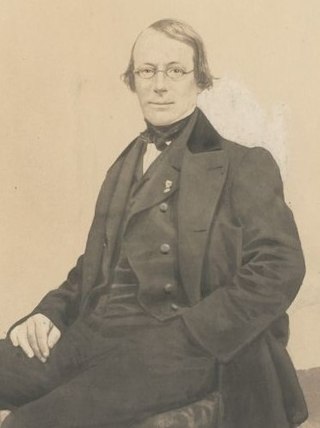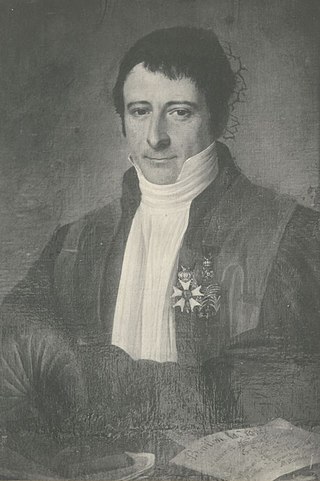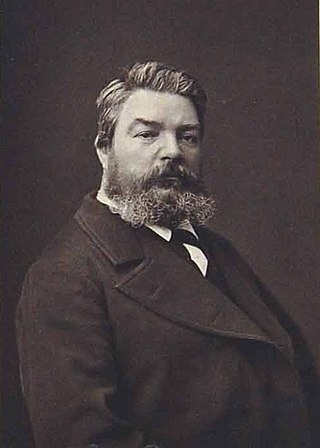Related Research Articles

Antoine Isaac, Baron Silvestre de Sacy, was a French nobleman, linguist and orientalist. His son, Ustazade Silvestre de Sacy, became a journalist.

Jean-Gaston Darboux FAS MIF FRS FRSE was a French mathematician.

Jean-Baptiste Geneviève Marcellin Bory de Saint-Vincent was a French naturalist, officer and politician. He was born on 6 July 1778 in Agen (Lot-et-Garonne) and died on 22 December 1846 in Paris. Biologist and geographer, he was particularly interested in volcanology, systematics and botany. The standard author abbreviation Bory is used to indicate this person as the author when citing a botanical name.

Jean-Baptiste Descamps was a French writer on art and artists, and painter of village scenes. He later founded an academy of art and his son later became a museum curator.

Félix Savart was a French physicist and mathematician who is primarily known for the Biot–Savart law of electromagnetism, which he discovered together with his colleague Jean-Baptiste Biot. His main interest was in acoustics and the study of vibrating bodies. A particular interest in the violin led him to create an experimental trapezoidal model. He gave his name to the savart, a unit of measurement for musical intervals, and to Savart's wheel—a device he used while investigating the range of human hearing.

Eugène Soubeiran was a French scientist.

Théodore (Nicolas) Gobley (French: [ɡɔblɛ]; 11 May 1811, in Paris – 1 September 1876, in Bagnères-de-Luchon, was the first to isolate and ultimately determine the chemical structure of lecithin, the first identified and characterized member of the phospholipids class. He was also a pioneer researcher in the study and analysis of the chemical components of brain tissues.
Mercury(I) sulfide or mercurous sulfide is a hypothetical chemical compound of mercury and sulfur, with elemental formula Hg
2S. Its existence has been disputed; it may be stable below 0 °C or in suitable environments, but is unstable at room temperature, decomposing into metallic mercury and mercury(II) sulfide.

Pierre Jean Robiquet was a French chemist. He laid founding work in identifying amino acids, the fundamental building blocks of proteins. He did this through recognizing the first of them, asparagine, in 1806, in the industry's adoption of industrial dyes, with the identification of alizarin in 1826, and in the emergence of modern medications, through the identification of codeine in 1832, an opiate alkaloid substance of widespread use with analgesic and antidiarrheal properties.

Jean Paul Louis François Édouard Leuge-Dulaurier was a French Orientalist, Armenian studies scholar and Egyptologist.

Pierre Lassus was a French surgeon born in Paris.

Edme-Jean Baptiste Bouillon-Lagrange was a French chemist and pharmacist. He was a professor of chemistry at the Ecole de pharmacie of Paris, later serving as director of the school.
Noël Étienne Henry was a French chemist and Chief Pharmacist of the hospitals of Paris. He was father of Étienne Ossian Henry (1798–1873) and grandfather of Emmanuel-Ossian Henry (1826-1867).

Émile Jean-Baptiste Philippe Bin was a French portraitist, mythology painter, watercolorist and politician.

Jean-Baptiste-Antoine Lassus was a French architect who became an expert in restoration or recreation of medieval architecture. He was a strong believer in the early Gothic architecture style, which he thought as a true French and Christian tradition, and was opposed to the classical Graeco-Roman styles promoted by the academic establishment.
Auguste-Arthur Plisson was a French chemist. Born in Orléans, Plisson was orphaned at an early age, but overcame the difficulties that caused him with the determination he brought to being a student of chemistry in Paris. Taught by Nöel-Étienne Henry, chief of the Central Pharmacy of Paris Hospitals, he won several awards from the School of Pharmacy of Paris, including a gold medal for chemistry in 1823, and was eventually recruited by Henry to work for the Central Pharmacy. After several years, during which he published a number of papers on chemical discoveries, he was appointed deputy chief. He was also a member of the Société de Pharmacie.

François-Louis Crosnier was a French theatre manager, politician, and playwright, who used the pen name Edmond Crosnier.
Jean-François-Madeleine de Gentil was a French officer who participated to the French conquest of Algeria.
Georges-Claude de Goiffon was a French architect, son of Jean-Baptiste Goiffon, a physician by profession, Georges-Claude was a member of the Académie des sciences, belles-lettres et art de Lyon from 1764 to 1766.

Gustave-Augustin Quesneville was a French chemist, chemical manufacturer, and journal editor, best known for the monthly Moniteur Scientifique Du Docteur Quesneville.
References
- 1 2 Jaime Wisniak (2016): "Nicolas-Jean-Baptiste-Gaston Guibourt". Educación Química, volume 27, issue 2, pages 163-171. doi : 10.1016/j.eq.2015.09.011
- ↑ (1867): "Acte de décès no 2049". Archives de Paris 5e.
- ↑ Nicolas-Jean-Baptiste-Gaston Guibourt (1816): "Thèse sur le Mercure et sur ses Combinaisons avec l’Oxigène et le Soufre". École Spéciale de Pharmacie. Also in Journal de Pharmacie, volume 2, pages 296-310 and 365-375. Also in Annales de Chimie, volume 1, pages 422-426.